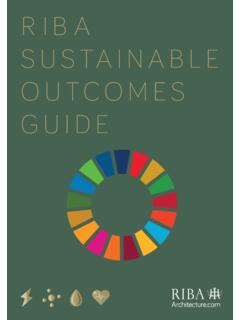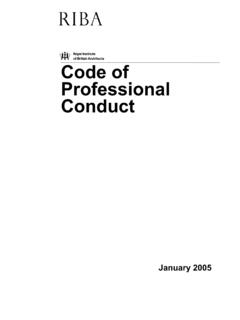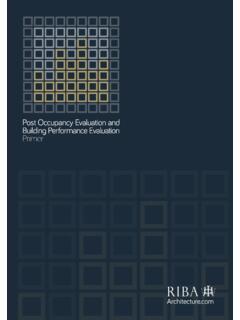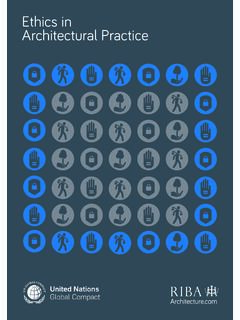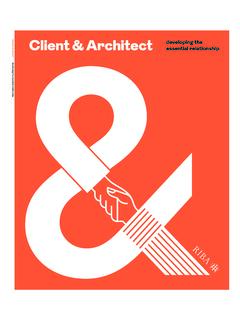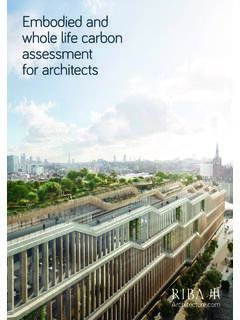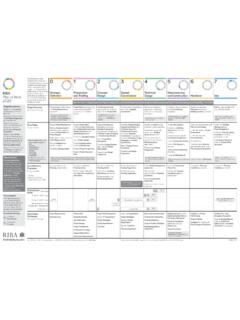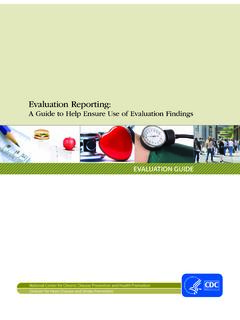Transcription of RIBA Plan for Use Guide
1 RIBAPlan for Use GuideRIBAPlan of Work2 RIBA Plan for Use Guide RIBA 2021 Published by RIBA, 66 Portland Place, London, W1B rights reserved. No part of this publication may be reproduced in any form or by any means, electronic, mechanical, photocopying, recording or otherwise, without prior permission of the copyright every effort has been made to check the accuracy and quality of the information given in this publication, neither the Editor nor the Publisher accept any responsibility for the subsequent use of this information, for any errors or omissions that it may contain, or for any misunderstandings arising from image.
2 David Attenborough Building Julieta Sarmiento ORP RIBA Plan for Use Guide 3 ForewordThere is no silver bullet. Averting the climate emergency demands radical, multi-dimensional change from all of us, designers, developers and users of the built environment alike. But when I was standing for election as President of RIBA, I was frequently challenged to name the one thing that I would like to see by the end of my two year term of office. In response, my answer was always the same: A consistent approach to Post Occupancy Evaluation that could be offered as part of Architects normal service offering on any project to any campaign slogan was #ChangeIsNecessary , and I argued for the basic behavioural change necessary to create an industry equipped with the feedback loop necessary to build a body of data and knowledge for continuous improvement.
3 If not a silver bullet, this is surely the essential pre-requisite, not only to overcoming the existential threat of climate change, but also to restoring an understanding of the value our profession brings to our clients and wider society in myriad other ways publication has been in the making for some time, hampered by the unusual events of the Covid-19 pandemic. But I am delighted that it now joins the impressive suite of guidance such as the Sustainable Outcomes Guide to sit alongside the Architects Plan of Work 2020. Collectively, the guides are essential tools in turning an industry focused on capital cost to one that delivers on outcomes of planetary and human wellbeing.
4 I hope these documents will enable a growing number of practices to adopt and deliver the stretching targets set out in the RIBA s Climate Challenge are obstacles of course. Fragmented procurement processes make it difficult to maintain the necessary continuum through the project life-cycle. Insurers may not be keen to encourage scrutiny of a kind that might reveal liabilities they would rather leave undiscovered. But establishing that golden thread through any procurement process is an outcome of the Hackitt Review on which we must are innovations we can pursue as a consequence of the virtuous cycle of post occupancy evaluation.
5 Performance based procurement of both professional services and construction are opportunities for a win-win through empirical measurement of selected outcomes that drive improvements for businesses and customers alike. For the professions, that would be the sure fire way of overcoming the common complaint that their contribution is am grateful to the team at RIBA, and the members who contributed their time voluntarily to create this guidance. It is now down to all of us to argue persuasively for its adoption in practice, and to show policymakers the way to performance evaluation in the procurement of a built environment that serves the needs of the Derbyshire Dip Arch Cantab IPPRIBA FRSA HonAIA Chair, HTA Design LLP Past President, RIBAH istoric England Commissioner4 RIBA Plan for Use Guide Introduction 4 What is Plan for Use ?
6 6 How and When to use this Guide 8 Chapter 1: The GuidanceRIBA Stage 0: Strategic Definition 12 RIBA Stage 1: Preparation and Briefing 14 RIBA Stage 2: Concept Design 18 RIBA Stage 3: Spatial Coordination 20 RIBA Stage 4: Technical Design 22 RIBA Stage 5: Manufacturing and Construction 24 RIBA Stage 6: Handover 28 RIBA Stage 7: Use 32 Chapter 2: Case StudiesCase Study Examples 36 Endnotes 61 Glossary 62 Further Reading 63 Acknowledgements 65 Contents RIBA Plan for Use Guide 5 IntroductionOf the challenges our profession and industry face in the coming decade, none are more pressing than those posed by climate crisis and the Grenfell tragedy.
7 Our response will define our profession as a progressive force for change: to be on the right side of clock is ticking. The financial crisis of 2008 and the decade of austerity that followed has seen a flat-lining of policy responses to carbon emission reduction across the developed world. So now, alongside other sectors, the construction industry must deliver an unprecedented programme of carbon reduction over the next 10 years. Investment in renewable energy, comprehensive adoption of passive design, whole-life costing and reduction in embodied carbon, alongside alignment with green infrastructure and transport must become standard if we are to avoid the worst impacts of climate change.
8 Dame Judith Hackitt s Report into the Grenfell Tower fire and Building Regulations was rightfully damming in its condemnation of the current state of our industry. In the preface she writes: Ours is an industry which has not reflected and learned for itself . Grenfell exposed the danger of prioritising cost over quality, opaque regulation with just enough compliance as well as the devolution of quality control and determination and application of the right strategy, we can and must achieve zero carbon buildings which perform to (or ideally better than) the expectations of client, designer and end user.
9 We must place greater emphasis on performance outcomes right from the start of a project, even prior to briefing, and have a strategy that embeds this emphasis throughout the project programme. Plan for Use is an essential part of this strategy which needs to be deployed if the challenges of the climate crisis and the Grenfell tragedy are to be is a greater emphasis on performance outcomes needed?As post occupancy data grows, the gap between design estimates of energy use and the of actual energy consumption is as much in evidence today as it was in the 1990s.
10 This is due in part to the design-to-compliance culture which allows Part L calculations to ignore un-regulated loads (the plugged-in equipment.) This accounts in part to why under estimation of electricity usage is more pronounced than the underestimation of gas. But this is not sole reason behind the performance gap. Over complexity of building services and controls, inadequate or rushed commissioning of building and service installations, lack of design co-ordination and poor-quality control are all contributing factors. These shortcomings not only result in high energy bills and related carbon emissions but may also manifest in lower levels of comfort and satisfaction amongst building users.

